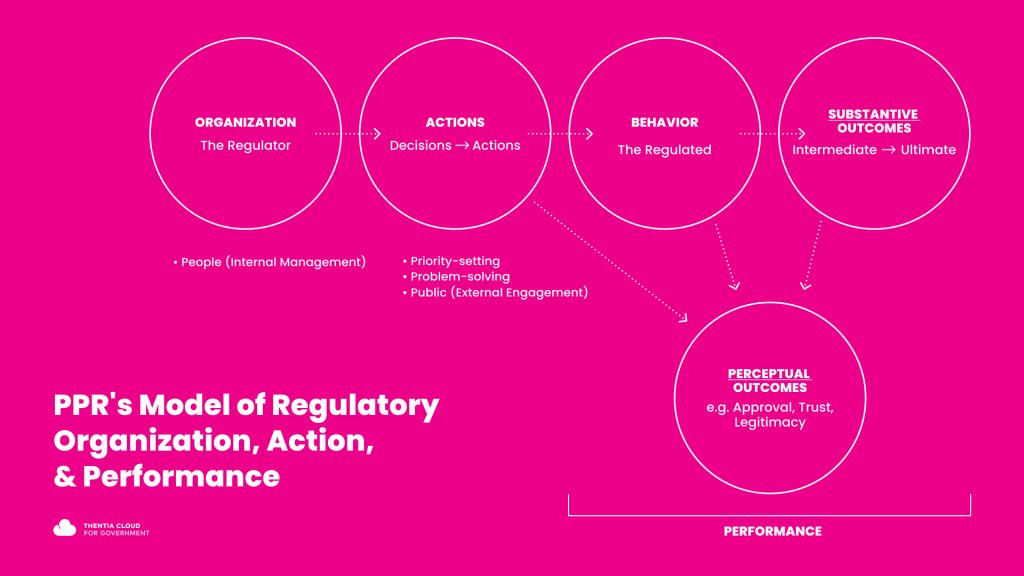In a previous article, we explored what defines regulatory excellence according to a report by experts at the University of Pennsylvania’s Penn Program on Regulation (PPR). Written by PPR Director Cary Coglianese, the report provides a general framework that any regulator can follow to achieve regulatory excellence.
In Part 1, we examined the three core elements – utmost integrity, empathetic engagement, and stellar competence – and nine tenets that define regulatory excellence and how regulators should align their organizational traits, actions, and outcomes to achieve it. Here, we’ll look at the practical steps regulators can take to put the theory into practice as recommended by the PPR team, and how they can measure their progress.
PPR recommendations for achieving regulatory excellence
Recognizing that no two regulators are exactly alike in terms of mission, the entities they regulate, and the contexts in which they operate – and therefore, that every regulator’s journey will ultimately be unique – the researchers offer five strategic recommendations that can be adopted by any regulator pursuing regulatory excellence:
- Align strategic priorities around all three core attributes of regulatory excellence: although regulators tend to pay most attention to stellar competence, as regulation is often viewed as a technical enterprise, the social nature of regulation – which demands a high level of integrity and empathic forms of public engagement – should not be overlooked.
- Align organizational culture with the three core attributes of regulatory excellence: leadership should ensure that excellence is baked into the entire culture of the organization by establishing management practices that appropriately align employee incentives with the attainment of all three core attributes.
- Build human capital that maintains stellar technical competence as well as ensures empathic engagement and continued commitment to professional and public integrity: stressing that regulatory excellence is ultimately “people excellence,” the researchers note that each individual who works at a regulatory body must strive to exhibit integrity, empathy, and competence at the highest level.
- Involve the public in operationalizing regulatory excellence and in identifying management priorities: the best regulators master empathic engagement in everything they do, and regulators must operationalize the three core attributes in a way that matches the distinctive mission and operational environment that they face. The strategic choices a regulator makes (e.g. improvement priorities and performance measurement) will be important for the future of both the regulator and the public it serves, and the public will benefit from open public input and engagement.
- Take a strategic approach to evaluation and performance measurement: leadership must first clearly define the purposes of evaluation and performance measurement, and then create learning systems to meet those purposes. No single measure will serve all purposes; overall performance measurement is a portfolio that needs to be managed strategically.
Putting it into action: four practical steps forward
To put the strategic recommendations into action, the researchers outline four concrete steps for any regulator seeking excellence:
- Self-awareness: conduct a full mapping out of the regulator’s organizational capacities, suite of activities, and current levels of performance to get the “big picture” of what the regulator is, does, and achieves.
- Scoping: evaluate how well the organization is aligned with the three core attributes and nine tenets of regulatory excellence for each circle in PPR’s Model of Regulatory Organization, Action, and Performance (below). The researchers provide a helpful framework to assist in scoping.
- Strategic action: Based on the self assessment and scoping exercises, leadership should select priorities, identify improvement strategies, and make performance measurement or evaluation plans, involving key stakeholders the regulator works with and serves where possible.
- Assessment and continuous improvement: assess how well the selected improvement strategies are working and repeat the cycle, thereby seeking continuous improvement.
To clarify where regulators should place their strategic emphasis, the PPR team also provides an “Excellent” Checklist for Regulators that helps regulators assess their approaches to the four key operational facets: internal management, priority-setting/decision-making, problem-solving, and external engagement.

How can regulators measure their progress?
Due to the differences between regulators and the difficulty of measuring values like transparency in concrete terms, Coglianese recognizes that “the measurement of overall regulatory excellence will never be easy or tidy.” Nonetheless, measurement is a vital way for regulators to gauge how they’re doing and what they must do to improve.
The PPR researchers differentiate between measurement of excellence and measurement for excellence. Measurement for excellence refers to the kinds of practices that an excellent regulator would put in place to run its day-to-day operations. These will be individualized according to the regulator’s sector and location and reflect both internal and external purposes, and broad and narrow focuses. Examples of internal measurements include application processing times and the time it takes for a regulator to resolve complaints, while emissions levels (in the specific case of an environmental regulator) would constitute an external measurement.
On the other hand, measurement of excellence seeks to determine how well a regulator’s traits, actions and outcomes are aligned with the core attributes of regulatory excellence. Rather than evaluate the specific things a regulator is performing, measurements of excellence provide a comprehensive, overall account of how a regulator is doing that can be compared to other regulators.
The PPR team recommends that measurements for excellence take precedence over measurements of excellence, and that regulators should aim to use measurements that put the production of public value front and center. But accomplishing this is easier said than done. The researchers point out that performance measurement systems can face several common challenges that can limit their effectiveness: they may not rely on the “right” key performance indicators (KPIs); errors could arise in measuring KPIs; the weights given to different measures of performance by the evaluator might differ from the weights other key stakeholders believe they should have; and the sum of the individual KPIs being measured might not lead to the “whole” that decision-makers desire.
And for government regulators, performance measurement is even more complicated, as the performance of the regulator is ultimately dependent on the actions of the entities being regulated. Because risk control is shared between the regulator and the regulated, a failure by the latter would inevitably be perceived as a failure of the former if an unforeseen disaster occurs, even if the regulator performs strongly according to a defined measurement system.
To overcome the limitations of performance measurement, regulators must clarify the purpose of measurement; use meaningful measures (defined as being relevant, reliable, and realistic); and avoid dysfunctional incentive structures, which can give the impression that the true objective of measurement is to hit a target rather than achieve public value. Though they acknowledge this isn’t an easy task, the researchers recommend using the 12 Principles for Public Sector Performance Management set out by public management scholar Donald P. Moynihan as a practical guide.
Excellent regulators must continue to improve
The PPR report offers a general framework on how regulators can chart a path towards excellence, but the researchers note that regulatory excellence is not something that regulators can pursue and then abandon efforts once they think they have achieved it. Rather, they stress that excellent regulators will always strive to be better and foster organizational cultures that prize continuous learning and improvement. Regulators must always approach emerging challenges and changes with boldness and vision – as the situation on the ground will always be evolving. “The excellent regulator cannot stay in one place, content to have mastered solving the problems of the past,” Coglianese writes. “The world changes, its problems change, its economies change, and its social concerns change. Excellence as a regulator requires forward momentum, not static achievement.”
No matter an organization’s size or focus, any regulator can implement the PPR team’s findings and recommendations in their own pursuit of regulatory excellence. In addition to the report explored here, the team published additional resources, including a series of discussion papers, on the Best-in-Class Regulator Initiative website that provide further insight and guidance.
For its part, the Alberta Energy Regulator (AER), which engaged the PPR team on the initiative, used the final report to create its own vision of how to achieve regulatory excellence, titled The Alberta Model for Regulatory Excellence. But their work didn’t end there. Following PPR’s recommendation that a truly excellent regulator should continuously learn and improve, AER continued to evolve their approach by engaging with citizens, indigenous people, employees, and other stakeholders to provide feedback on how the organization was performing and how they could do better. The resulting report, What We Heard, helped AER refine their strategy going forward.








